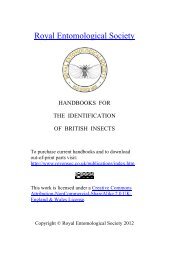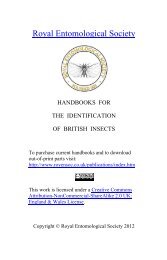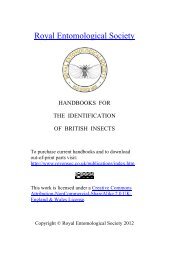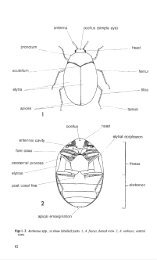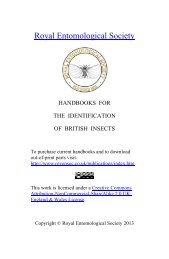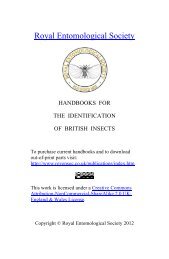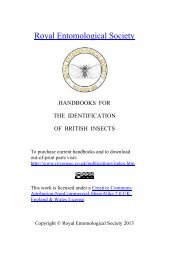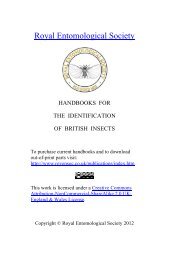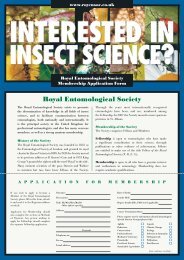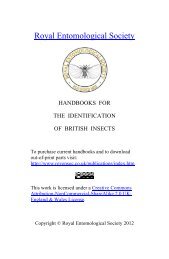Vol 5 Part 12. Coleoptera. Cerambycidae. - Royal Entomological ...
Vol 5 Part 12. Coleoptera. Cerambycidae. - Royal Entomological ...
Vol 5 Part 12. Coleoptera. Cerambycidae. - Royal Entomological ...
- No tags were found...
You also want an ePaper? Increase the reach of your titles
YUMPU automatically turns print PDFs into web optimized ePapers that Google loves.
LAMIINAE 15Outer side of first antenna! segment without a black carina. Elytra elongate, twoand one-half to three times as long as combined basal width. Mesosternum fiat,not protruding between middle coxae ...... .. . ............ ... ............... ............ ll.10 Thorax with two pairs oflateral, short, blunt tubercles, one above the other. Elytrawith scattered greyish-white patches of pubescence, especially at the base;shoulders very strongly prominent. Length 12-20 mm. African species* Coptops aedificator Fabricius.Thorax without lateral tubercles. Elytra with greyish white patches confined tomiddle ; shoulders slightly prominent. Length 10-15 mm. Chiefly fmmQuercus ... ... ... ... ... ... .. . ... .. .... ... ... .. . ... ... ... ... ... Mesosa nebulosa (Fabricius).ll Antennae 12-segmented. Hind tarsi as long as hind tibiae. Length 12- 17 mm.From herbaceous plants, especially Carduus and HeracleumAgapanthia villosoviridescens (Degeer).Antennae ll-segmented. Hind tarsi distinctly shorter than hind tibiae. Fromdeciduous trees ......... ... .................. ... ... ... ...... .. .................. . Saperda (p. 16).12 Elytra yellow with apices black. Eyes completely divided into two parts. Thoraxwith a very deep transverse impression on each side near base. Length 3-5 mm.Tetrops praeusta (Linnaeus).Elytra completely grey, dark or black. Eyes not completely divided into two parts.Thorax without a deep transverse impression near base .................. ... ... ... 13.13 Thorax and abdomen yellow. Elytra strongly emarginate at apex (fig. 30). Hindtibiae not nearly reaching apices of elytra. Length 16-20 mm. From SalixOberea oculata (Linnaeus).Thorax and abdomen black. Elytra not or scarcely emarginate at apex . Hindtibiae reaching apices of elytra ............ ... ............ .. .......... ... ... ... ... ... ... ... 14.14 Elytra each with one or two slightly raised longitudinal ridges and very graduallytapering posteriorly. Front femora and tibiae yellow. Length 6-10 mm. FromUmbelliferae .. ....... ...... ............ ... ...... .......... Phytoecia cylindrica (Linnaeus).Elytra without ridges and slightly broadened towards apices. Front femora andtibiae black. Length 9- 12 mm. Chiefly from TiliaStenostola ferrea (Schrank).(*) Monochamus.1 Apices of elytra each produced at suture into a short spine. Elytra light reddishbrownwith small scattered white markings. Length 22-30 mm. North Americanspecies ... ... ... ... ... ...... ... ... ... ... ... ... ... ... ... ... ... ... * M. titillator Fabricius.Apices of elytra rounded, without spines. Elytra black, usually with white oryellow markings ... ... ... ... ......... ... ...... ............ ............ ............ .. .......... ... 2.2 Antennae reddish-brown ; segments usually obscurely ringed with white in thefemale ... ... .. .... ...... ... ............... ...... ............ ......... .................. ............ 3.Antennae black ; segments distinctly ringed with white in the female ... ... ... ... 5.3 Elytra with apical third very densely and evenly covered with greenish-yellowpubescence. Scutellum completely and densely covered with yellow pubescence.Length 20-35 mm. European species ... ... .........* M. rosenmiilleri (Cederhjelm).Elytra with apical third not covered with greenish-yellow pubescence ; either withsmall white patches or with sparse brown, patchy pubescence. Scutellum notcompletely covered with pubescence ............... .................. .....................4.4 Pubescence of scutellum narrowly but distinctly interrupted by a narrow longitudinalmedian black line. Elytra with a slightly bronzed lustre. Length 13-23 mm. North American species ... ......... ............ .. . ...... * M. scutellatus Say.Pubescence of scutellum broadly interrupted at base by a semicircular glabrousarea, so that the pubescent area is U-shaped. Elytra without a bronze lustre.Length 13- 23 mm. European species ... ... ... .. . * M. galloprovincialis (Olivier).5 Elytra (viewed laterally) with a very shallow, rather broad transverse depressionjust before middle. Pubescent area completely covering scutellum. Length26-32 mm. European species ...... ............ ... ...... ...... ...* M. sartor (Fabricius).E lytra without a transverse depression. P ubescent area of scutellum narrowly butcompletely divided longitudinally. Length 18-25 mm. European species(*) M. sutor (Linnaeus).Pogonocherus.1 E lytra subtruncate at apex; not dentate or m ucronate. Length 5-7 mm. Northernspecies. From coniferous trees ...... ... ... ... ... ... ... ... ... P. fasciculatus (Degeer).




